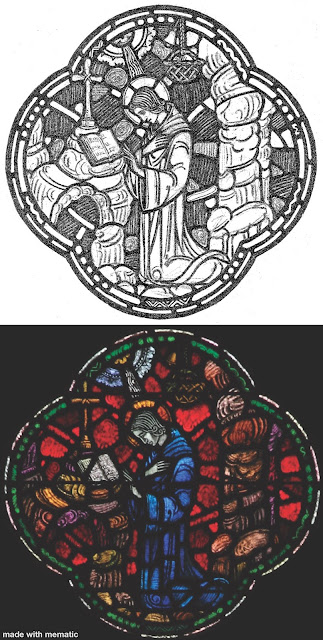It would seem that humanity permanently values truth, goodness, and beauty. These values or states of being are essential to religion. The great artistic brilliance of stained glass and painted windows in churches helps to bestir the imagination and speak to the soul through a harmonious reflection of heavenly beauty.
Sainted glass windows are an integral part of beauty and architecture. Sir Roger Scruton speaks of the human longing for beauty: "There is a deep human need for beauty, and if you ignore that need in architecture your buildings will not last."
Following is the brief story of ecclesiastical glass maker Angelo Leopardo Pitassi (1886-1947). He was a talented artist who specialized in designing medieval style stained glass windows for churches, libraries, and other customers. His daughter Louise Ellis (1926-2020), followed in her father's footsteps and continued their work at the Pitassi Stained Glass Studio in Pittsburgh, Penn. Following is a brief account of his story. I hope this will help to support aspiring stained glass artisans:
Angelo Leopardo Pitassi was born in Pacentro, Italy (the province of L’Aquila) in 1886. He was educated in the Catholic Seminary of Sulmona from the age of eight to eighteen, living at home only in the summers. His studies and religious training prepared him in many ways for his life’s work, creating stained glass windows for churches.
In 1903 he emigrated alone to the United States of America. He worked in New York City at a variety of jobs to support himself. Naturally gifted in the visual arts, he began to apprentice in stained glass studios in New York, Philadelphia, and Pittsburgh. In the early twentieth century Pittsburgh was an important center for this art, which was pioneering the revival of the great medieval style of the 12th and 13th centuries. Pitassi joined this movement and while working he attended Carnegie Technology School of Fine Arts at night for five years. He became a much-sought-after designer.
By 1920 Pitassi’s dream was to build his own independent studio which became a reality in 1926. During this period he and Hazel Wright were married in 1923 and had their only child, Louise, in 1926. Also in 1926 the building of his studio was completed at 5345 Penn Avenue, Pittsburgh, PA. This initiated two decades of being his own creative boss. Unlike big production-oriented studios, Pitassi drew all the full-size window designs and participated in all the art procedures that followed. For the mechanical work he hired cutters and glazers. Mr. Pitassi’s ideal studio method allowed a personal artistic statement to evolve; he worked in an atmosphere where art could happen.
With glass, lead, fire and brush, and the artistic vision of Angelo Leopardo Pitassi, the windows of Saint Benedict Church in Baltimore were born. Using an ancient technique of fired and painted glass along with an antique art glass called Normandy, Pitassi crafted the life and miracles of Saint Benedict in 27 roundels, as well as many ancillary panes. The overall effect is best viewed at a distance so that the serene beauty of the composition and positioning of colors may be appreciated and experienced.
Source: Art and Architecture — Saint Benedict Church
















